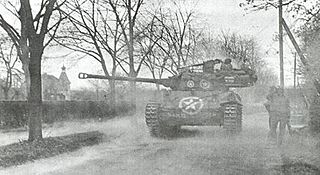
The Guards Armoured Division was an armoured division of the British Army during the Second World War. The division was created in the United Kingdom on 17 June 1941 during the Second World War from elements of the Guards units, the Grenadier Guards, Coldstream Guards, Scots Guards, Irish Guards, Welsh Guards, and the Household Cavalry.

The 8th Armored Division was an armored division of the United States Army that served in the European Theater of World War II.

The 14th Armored Division was an armored division of the United States Army assigned to the Seventh Army of the Sixth Army Group during World War II. It remains on the permanent roll of the Regular Army as an inactive division, and is eligible for reactivation. The division is officially nicknamed the "Liberators".

The 100th Training Division (Leader Development) (formerly the 100th Infantry Division) is a division of the United States Army headquartered at Fort Knox, Kentucky. It currently serves as a major training command of the United States Army Reserve. It has been known as the "Century Division" owing to its "100th" designation.

The 91st Air Landing Division was a German Army infantry division in World War II.

The 8th Panzer Division was a formation of the WehrmachtHeer. The division was formed by reorganising the 3rd Light Division in October 1939. It was transferred to the west and fought in the Battle of France, in May 1940, and the German invasion of the Balkans in April 1941. Soon after the division advanced towards Leningrad under Army Group North in Operation Barbarossa, and would remain on the eastern front for the remainder of the war. Staying on defensive fronts, it saw action in the relief of Kholm in 1942, Orel and the withdrawals of Army Group Centre in 1943, until transferred to Army group South. The division then fought in a series of retrograde movements, back through Ukraine, into Hungary and finally into Silesia and surrender in May 1945.

The 9th Panzer Division was a panzer division of the German Army during World War II. It came into existence after 4th Light Division was reorganized in January 1940. The division was headquartered in Vienna, in the German military district Wehrkreis XVII.

The 17th SS Panzergrenadier Division "Götz von Berlichingen" was a German Waffen-SS division that saw action on the Western Front during World War II.

The Battle of Tannenberg Line or the Battle of the Blue Hills was a military engagement between the German Army Detachment Narwa and the Soviet Leningrad Front. They fought for the strategically important Narva Isthmus from 25 July–10 August 1944. The battle was fought on the Eastern Front during World War II. The strategic aim of the Soviet Estonian Operation was to reoccupy Estonia as a favorable base for the invasions of Finland and East Prussia. Waffen-SS forces included 24 volunteer infantry battalions from the SS Division Nordland, the SS Division Langemarck, the SS Division Nederland, and the Walloon Legion. Roughly half of the infantry consisted of the personnel of the 20th Waffen Grenadier Division of the SS. The German force of 22,250 men held off 136,830 Soviet troops. As the Soviet forces were constantly reinforced, their overall casualties are estimated by Estonian historian Mart Laar to be 170,000 dead and wounded.

The 44th Infantry Division was formed on 1 April 1938 in Vienna, about two weeks after the Anschluss of Austria. It first saw combat at the start of the war in the Invasion of Poland, and also took part in the Battle of France in 1940. After a 9-month period of coastal defence the division was transferred East. On 22 June 1941, the division took part in the invasion of the Soviet Union, attached to Army Group South. It remained in the east after the failure of "Operation Barbarossa", taking part in defensive actions for the winter against the Soviet Army offensives near Izum and Kharkov. Refurbished, the division participated in the German summer offensive, and was subsequently destroyed with the 6th Army at Stalingrad in January 1943.

The Battle of Troina was an important battle that took place between 31 July and 6 August 1943, as part of the Allied invasion of Sicily during World War II. Forces of the U.S. II Corps, part of the U.S. Seventh Army, under George S. Patton, engaged in fierce fighting around the town of Troina in the central portion of Sicily along the Caronie Mountains. The battle focused around the numerous hills and mountains surrounding Troina which the Germans had heavily fortified and used as bases for direct and indirect fire.

During the Second World War, Operation Clipper was an Allied offensive by the British XXX Corps to reduce the Geilenkirchen salient in mid-November 1944. Clipper was the preliminary to a wider Allied operation, Operation Queen, to gain control of the Roer valley and of the Hürtgen Forest.

Operation Jupiter was an offensive by VIII Corps of the British Second Army from 10 to 11 July 1944. The operation took place during the Battle of Normandy in the Second World War. The objective of the 43rd (Wessex) Infantry Division was to capture the villages of Baron-sur-Odon and Fontaine-Étoupefour and Chateau de Fontaine-Étoupefour, and to recapture Hill 112. An attached brigade of the 15th (Scottish) Infantry Division would take Éterville, Maltot and the ground up to the River Orne and then the tanks of the 4th Armoured Brigade, supported by infantry, would advance through the captured ground and secure several villages to the west of the River Orne. It was hoped that the initial objectives could be captured by 9:00 a.m., after which the 4th Armoured Brigade would exploit the success.

This is a sub-article to Battle of Narva (1944).
Battle of Monte Cassino order of battle January 1944 is a listing of the significant formations that were involved in the fighting on the Winter Line January 1944 during the period generally known as the First Battle of Monte Cassino.
Second Battle of Monte Cassino order of battle February 1944 is a listing of the significant formations that were involved in the fighting on the Winter Line in February 1944 during the period generally known as the Second Battle of Monte Cassino.
The Central Army Group (CENTAG) was a NATO military formation comprising four Army Corps from two NATO member nations comprising troops from Canada, West Germany and the United States. During the Cold War, CENTAG was NATO's forward defence in the southern half of the Federal Republic of Germany (FRG). The northern half of the FRG was defended by the four Army Corps of NATO's Northern Army Group (NORTHAG). During wartime, CENTAG would command four frontline corps. Air support was provided by Fourth Allied Tactical Air Force.

The 824th Tank Destroyer Battalion was a tank destroyer battalion of the United States Army active during the Second World War. It saw service during 1944–45 in the European Theater of Operations, primarily attached to the 100th Infantry Division in an infantry support role. After fighting through France and southern Germany, the battalion ended the war in Austria.

The Battle of Buchhof and Stein am Kocher was a seven-day battle fought between the 17th SS Panzergrenadier Division Götz von Berlichingen and 253rd Infantry Regiment, 63rd Infantry Division, First Battalion, 398th Infantry Regiment, 100th Infantry Division and the 753rd Tank Battalion. It was fought between the Neckar River and the Kocher River, and the three major points that had fighting in them were the areas around and the towns of Untergriesheim, Buchhof, and Stein am Kocher. These three towns were major battles between the Jagst and Kocher Rivers over the period of 4–12 April 1945. The Battle between the Jagst and Kocher Rivers was the northern section of the Battle of Heilbronn.
Independent Division of Guangxi Military District(Chinese: 广西军区独立师)(2nd Formation) was formed in April 1979 by 41st Army Corps in Chongzuo, Guangxi. The division was under the control of Guangxi Military District.



















